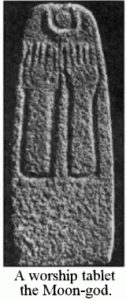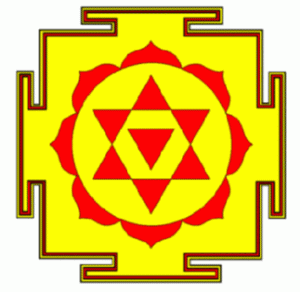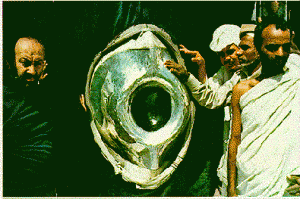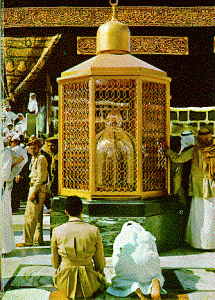Vedic Past of Pre-Islamic Arabia – Part 3
The Hindus of Arabia lived in a land where their forefathers had lived and prospered for ages past. They were proud inheritors of the ancient Vedic culture and religion. Mecca was a city whose commerce was expanding greatly and whose power and prestige were well established. Meccans were content, prosperous and devoted to the religion of their ancestors. The Kaaba temple drew thousands of devotees from around the world. Trade and barter flourished greatly, due to the immense number of visitors who came to Mecca on pilgrimage. The members of the Qurayshi tribe to which Mohammad belonged, were the priests who performed the rites and rituals for these pilgrims, thereby deriving their very livelihood from the Vedic gods of the Kaaba. It is no wonder that the majority of them later rejected Muhammad’s new religion and paid for it with their lives. In any case the Meccans were exceedingly devoted to their gods and very satisfied with the state of their lives. They were not at all on the lookout for a new cult or savior who could rescue them from a miserable state or lead them into a promised land. They had rejected Monotheism wholeheartedly during the short lived Jewish regime in Yemen and their Vedic gods had protected them very well against the Abyssinian Invasion. They were skeptical and amused by prophets foaming at the mouth and dismissed them as magicians or just plain lunatics. They did not want to hear any so called “revelations” or so called heavenly “messengers”. In short the Arabs were noble, content people, who felt spiritually enriched and materialistically satisfied. It is only in such successful societies that the qualities of tolerance, equality of the sexes, independence, love of free thinking, and cultural enrichment can exist.
When Muhammad first started preaching his “new” religion the Meccans tolerated it as they had tolerated many such propounders of “new” religions before. However they were startled out of their tolerance when the small band of Islamists started to publicly ridicule the Vedic heritage of the Meccans and threatened to break down the idols, which were the pride of Mecca. At first they proceeded in a calm manner to Muhammad’s uncle Abu Talib and told him that his nephew had “cursed our gods, insulted our religion, mocked our way of life and accused our revered forefathers of error. We request you to restrain him.”
It should be pointed out that the Meccans NEVER said Muhammad could not preach his religion, all they asked was that in the true spirit of tolerance, he ought to respect their way of life and religion, just as they were willing to let him uphold his.
But Muhammad continued insulting the Vedic heritage of the Meccans. He considered his epileptic fits as periods of divine revelation and his bitter invectives against the Vedic religion grew stronger. The Arabs of Mecca were now convinced that Muhammad was a lunatic who deserved only pity. This charge stung Muhammad to such an extent that he retorted bitterly “By him who holds my life in his hand, I bring you slaughter”. and came up with revelations such as:
“And they will see which one of you is demented. Therefore obey not your rejectors who would have you compromise; Neither obey you each feeble oath-monger,detractor, spreader of slander, hinderer of the good, an aggressor, malefactor, greedy therewithal, intrusive. We shall brand him on the nose!” (Quran 68:5-6, 68:8-13).
The Meccans were now stunned and convinced that such virulence and hatred could only come from one who is possessed by an evil spirit. They sent Utba B. Rabia one of their chiefs to Muhammad. Utba kindly explained to him that ” If this ghost which comes to you is such that you cannot get rid of him, we will find a physician for you and exhaust our means in getting you cured, for often a spirit takes possession of a man until he can be cured of it.” Muhammad reacted violently and warned the Meccans to leave him alone. The patience of the Arabs had come to an end, they decided it was time to fight back.
In the spirit of their Vedic culture , they invited Muhammad to an open debate. It was soon obvious from the debates that Muhammad could not present arguments in a logical manner. He would lose his temper and resort to violent and insulting answers to the questioners. Soon after he claimed a divine revelation that instructed him not to participate in open debate, to evade questions, and if questioned by unbelievers to retire! (Quran 6:68-70)
Now the Meccans were amused that a man like Muhammad who was distinguished neither by birth or education should go around proclaiming himself to be a prophet. When he started producing revelations about Moses and Jesus having performed miracles, they asked Muhammad to do the same. Unlike Moses and Jesus however, Muhammad could not produce a single miracle. Instead he came up with a revelation that the Meccans were not likely to believe in a miracle even if it were shown to them!
Now the Meccans were convinced about the falsity of Muhammad’s claims. Their faith in their Vedic deities was absolutely unshaken. Moreover they were enraged by the fact that Muhammad had taken their principal god Allah (Durga) and made her into the jealous deity of his new religion. They met him and said:
“Muhammad either you will stop cursing our gods or we will curse this Allah of yours.”
Muhammad then threw a challenge to the Meccans to produce revelations such as his. The challenge was accepted by Al Nadr B. Harith, a Meccan chief who said
“I can tell better stories than him…In what respect is Muhammad a better story teller?”
Al Nadr proceeded to tell several stories in verses, which were even better than the verses of the Quran. Muhammad was enraged and never forgave Al Nadr for this defeat. Later on Muhammad had Al Nadr brutally executed.
Muhammad had started preaching about how Judgement would come and bring destruction to the Non-believers. The Meccans however were not cowed down by mere threats. They challenged Muhammad to hurry up and bring down the Doom upon them. They said:
“You have disputed with us and multiplied disputation with us. Now bring down upon us that wherewith you threaten us, if you are truthful O Allah! If this indeed be the Truth from you, rain down stones on us or bring us some painful Doom…Our Lord! Hasten us for our fate before the Day of Reckoning…When will it come to port? When will the promise be fulfilled if you are truthful? When is the Day of Judgement?..”
The Meccans threw this challenge again and again. Muhammad had to wriggle out of the situation somehow. He came up with another convenient revelation:
“Knowledge thereof is with My Lord, He alone can manifest it at the proper time…It comes not to you save unawares…But Allah will not punish them while you (Muhammad) are with them… For every nation there is an appointed time…It is (only) then when it has befallen that you will believe.. And it is in the Scriptures of the men of Old..Is it not a portent for them that the doctors of the Children of Israel know it? You (Muhammad) are but the warner sent to them…So withdraw and await the event” (Quran 50:4 , 75:3-4, 79:13-14, 56:49-57)
It was obvious that the Prophet had begun contradicting himself, the paradox was in the verse itself, for how could Allah tell Muhammad to await the Event of the Day of Judgement when he had made it clear that it would not happen while Muhammad was alive!
The knowledgable Meccans had by now realized that Muhammad was only stealing things that he had learned from the Jews and the Christians. He was taking Biblical lore and conveniently twisting it to conform with his own “divine” religion. Moreover it was obvious that Muhammad was coming up with “holy verses” whenever the occasion demanded for his convenience. The incident that confirmed their suspicion was the Satanic Verses which say:
“Have Ye thought of Al-Lat and Al-Uzza and Manat the third, the other, these are the Gharaniq whose intercession is approved.”(Quran 53:19-27)
The Satanic Verses of the Quran clearly state that Al-Lat and Al-Uzza and Manat (Alla = Durga, Oorja = Shakti (life-force) and Somnath = Shivji) are exalted and their intercession is approved. The Meccans were overjoyed that Muhammad had finally endorsed the Vedic deities, but because of the pressure of his followers, Muhammad had to withdraw the verses.
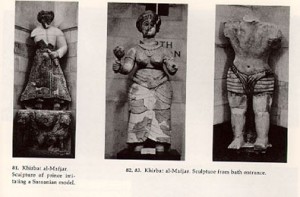
Sculptures of Pre-Islamic Gods
This was the last straw. The Meccans were now convinced of the lies perpetuated by Muhammad. Their chieftains said:”We can surely see your foolishness and we deem you as a liar, It is all the same to us whether you preach or not, Our hearts are protected from your words and our ears are deaf to you, Between us and you there is a veil drawn.”and to their people “Heed not this Quran and drown the hearing of it!”
Muhammad’s mission at Mecca had failed. The Arabs with their fierce love for their Vedic heritage and intelligence had seen through the “Prophet’s machinations and rejected him whole-heartedly. Thus it was an embittered, furious and vengeful Muhammad who was forced to flee to Medinah.
It is no secret what the Prophet did after this “migration” to Medinah. The story has been documented in detail by his biographers, – surprise raids on trade caravans and tribal settlements, the use of plunder thus obtained for recruiting an ever growing army of greedy desperados assassinations of opponents, expropriation, expulsion and massacre of the Jews of Medinah, attack and enslavement of the Jews of Khybar, rape of women and children, sale of these victims after rape, trickery, trachery and bribery employed to their fullest extent to grow the numbers of his religion Islam which ironically was supposed to mean “Peace”! He organised no less than 86 expeditions, 26 of which he led himself.
The motives of the converts to Islam was never in any doubt. As D.S. Margoliouth states in his book Muhammad and the rise of Islam
“Of any moralising or demoralising effect that Muhammad’s teaching had upon his followers we cannot say with precision. When he was at the head of the Robber community, it is probable that the demoralising influence began to be felt.; it was then that men who had never broken an oath learnt that they might evade their obligations, and that men to whom the blood of their clan had been as their own, began to shed it with impunity in the “cause of god”. And that lying and treachery in the cause of Islam received divine approval. It was then too that Moslems became distinguished by the obscenity of their language. It was then too, that the coveting of goods and wives possessed by Non-muslims was avowed without discouragement from the Prophet….”
On another occasion Muhammad was greatly criticised by his followers when he compromised his principles completely. After feeling very confident about the consolidation of his position in Medinah, Muhammad decided the time had come to take Mecca. But he soon realized that he had miscalculated the timing of his attack and at the last moment entered into negotiations with the Meccans. The Treaty of Hudaibiya permitted Muhammad to perform the pilgrimage to Mecca the following year, but in return he had to refrain from calling himself the “Prophet” and to refrain from preaching the formula of Islam. Muhammad agreed to all the conditions, and broke the Treaty much later. No wonder Dr. Magoliouth refers that:
“Muhammad’s career as tyrant of Medinah is that of a robber chief, whose political economy consists in securing and dividing plunder, the distribution of the latter was carried out on principles which fail to satisfy his follower’s sense of justice. He is himself an unbridled libertine and encourages the same passion in his followers. For whatever he does he is prepared to plead the express authorization of the deity (Allah). It is however impossible to find any doctrine which he is not prepared to abandon in order to secure a political end. At different points in his career he abandons the Unity of God and his claim to the title of Prophet. This is a disagreeable picture for the founder of a religion and it cannot be pleaded that it is a picture drawn by an enemy…”, this is the character attributed to Muhammad in the biography by Ibn Ishaq.
In my next article, I will describe the trail of murder, mayhem and destruction that was effected by the Prophet after he had recruited enough people in his fold.
Aditi Chaturvedi
Note: Works of P.N. Oak, D.S. Margoliouth and Sita Ram Goel have been used to compose this article.

